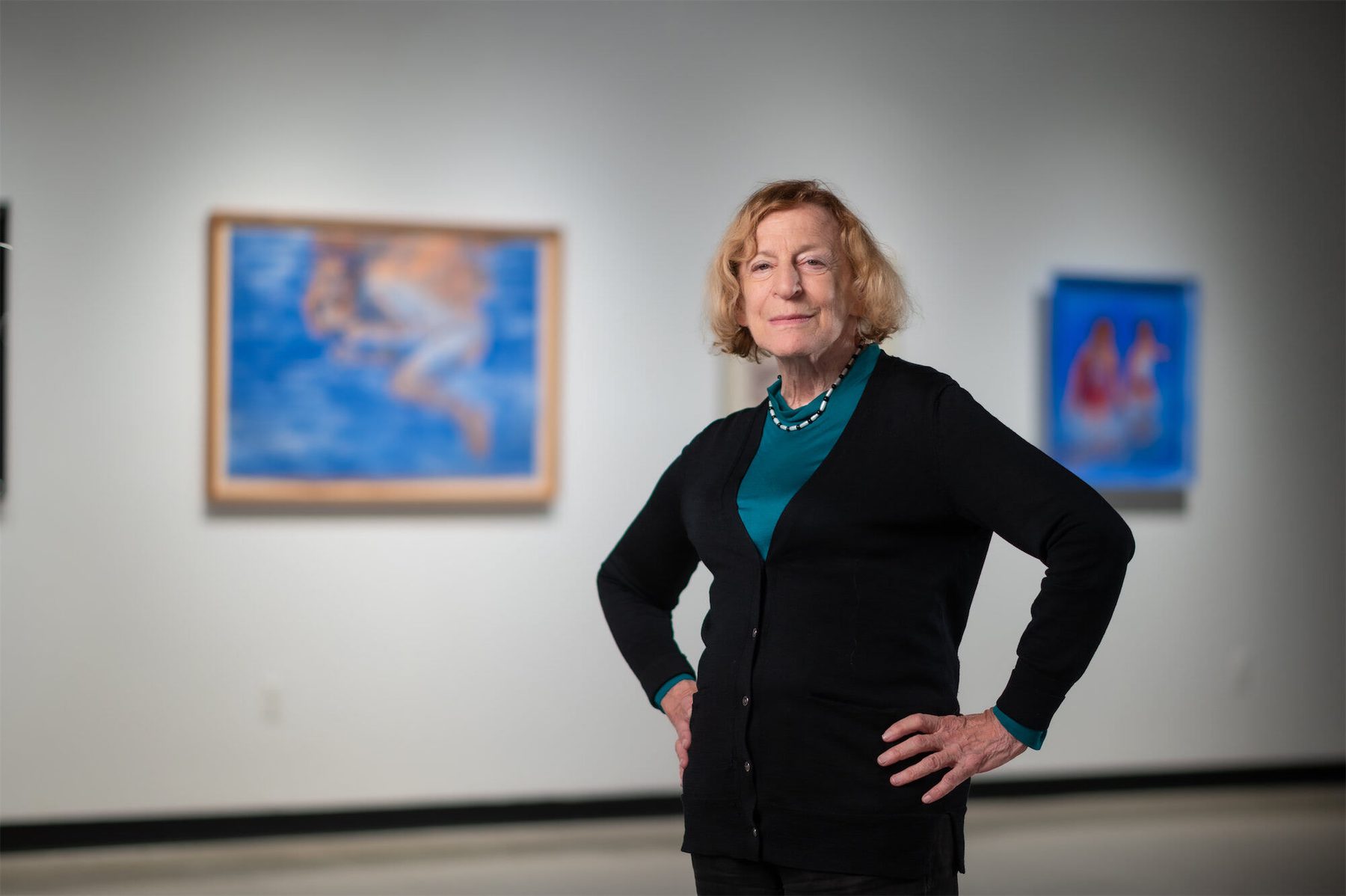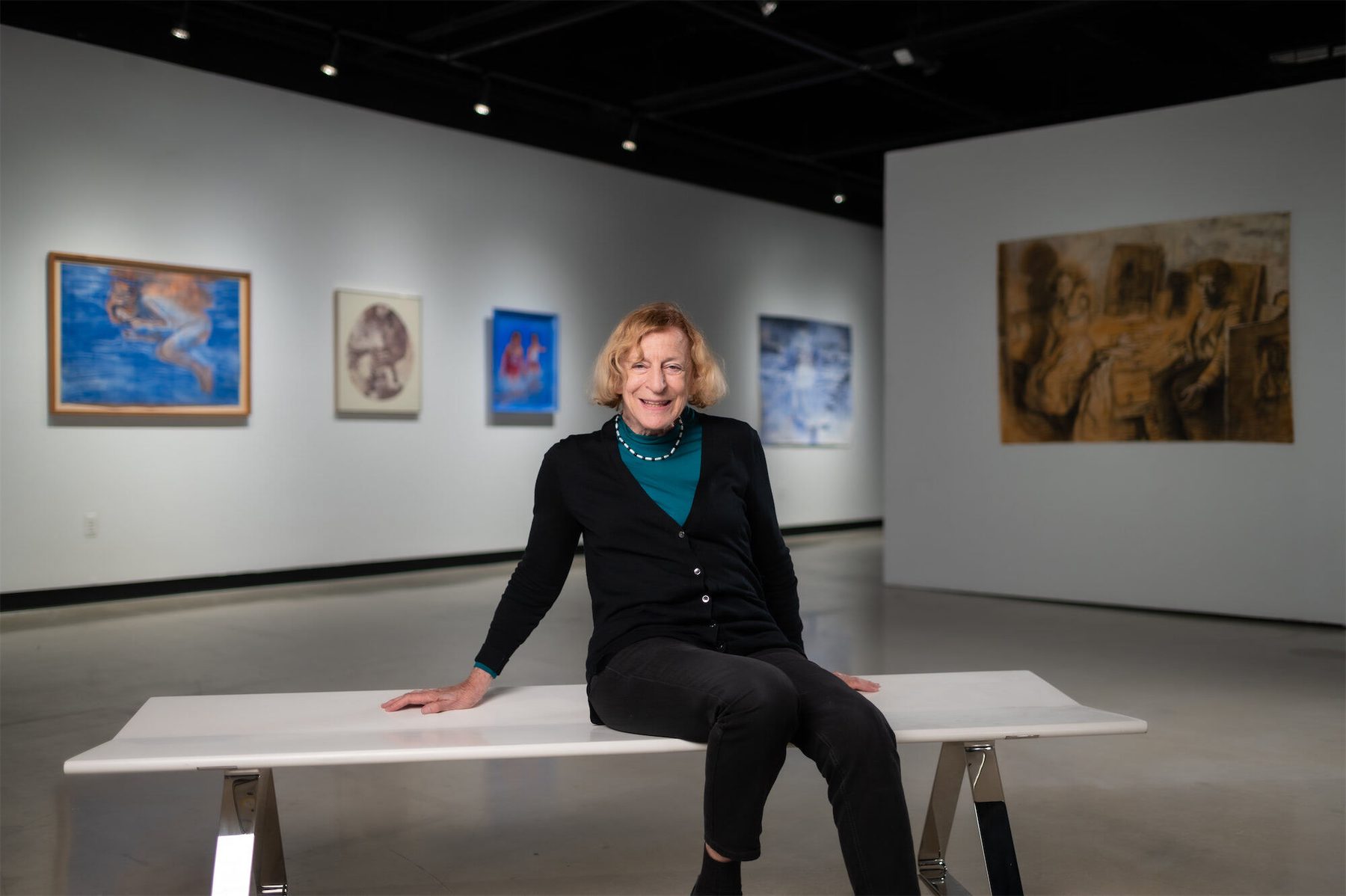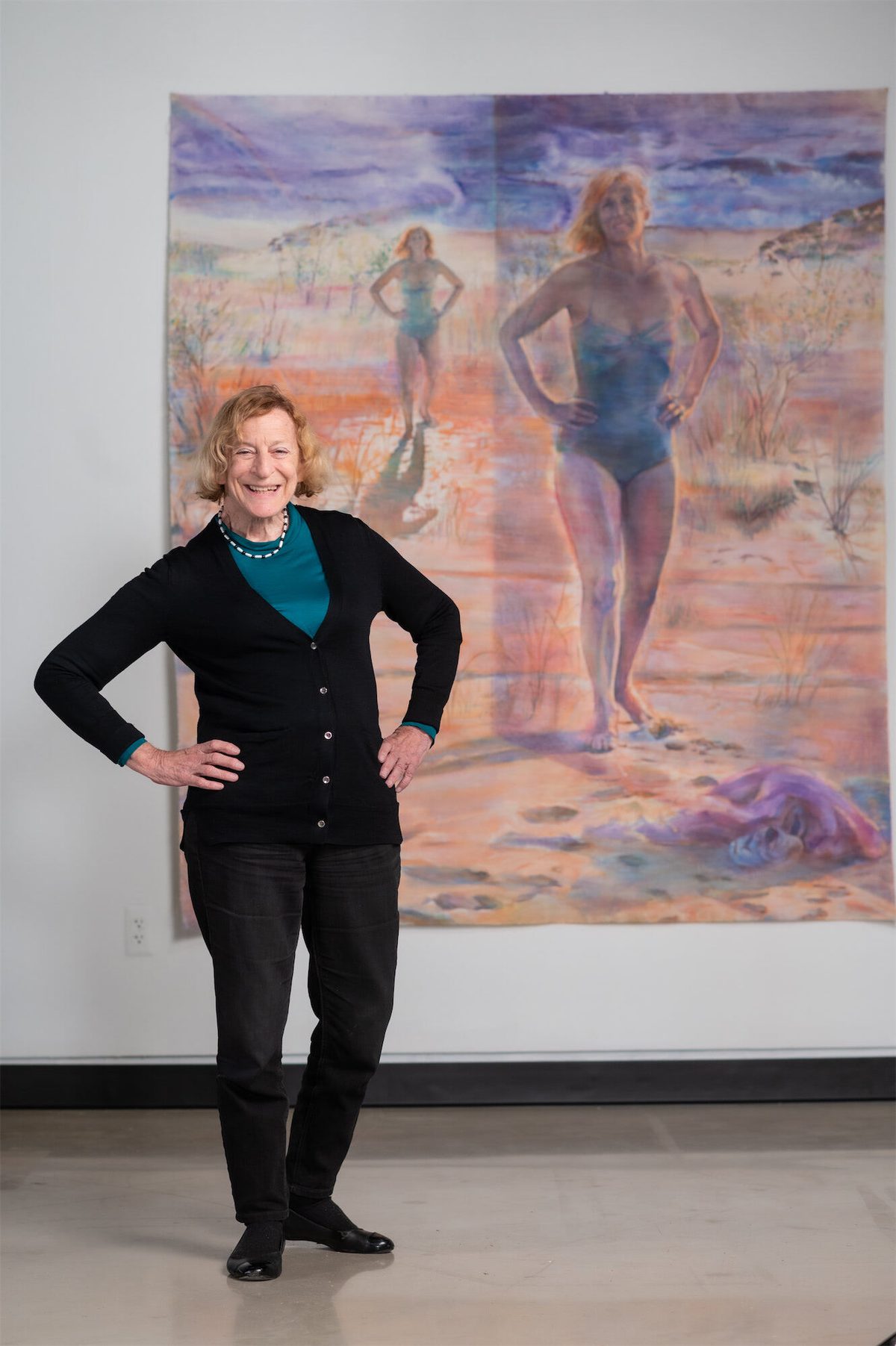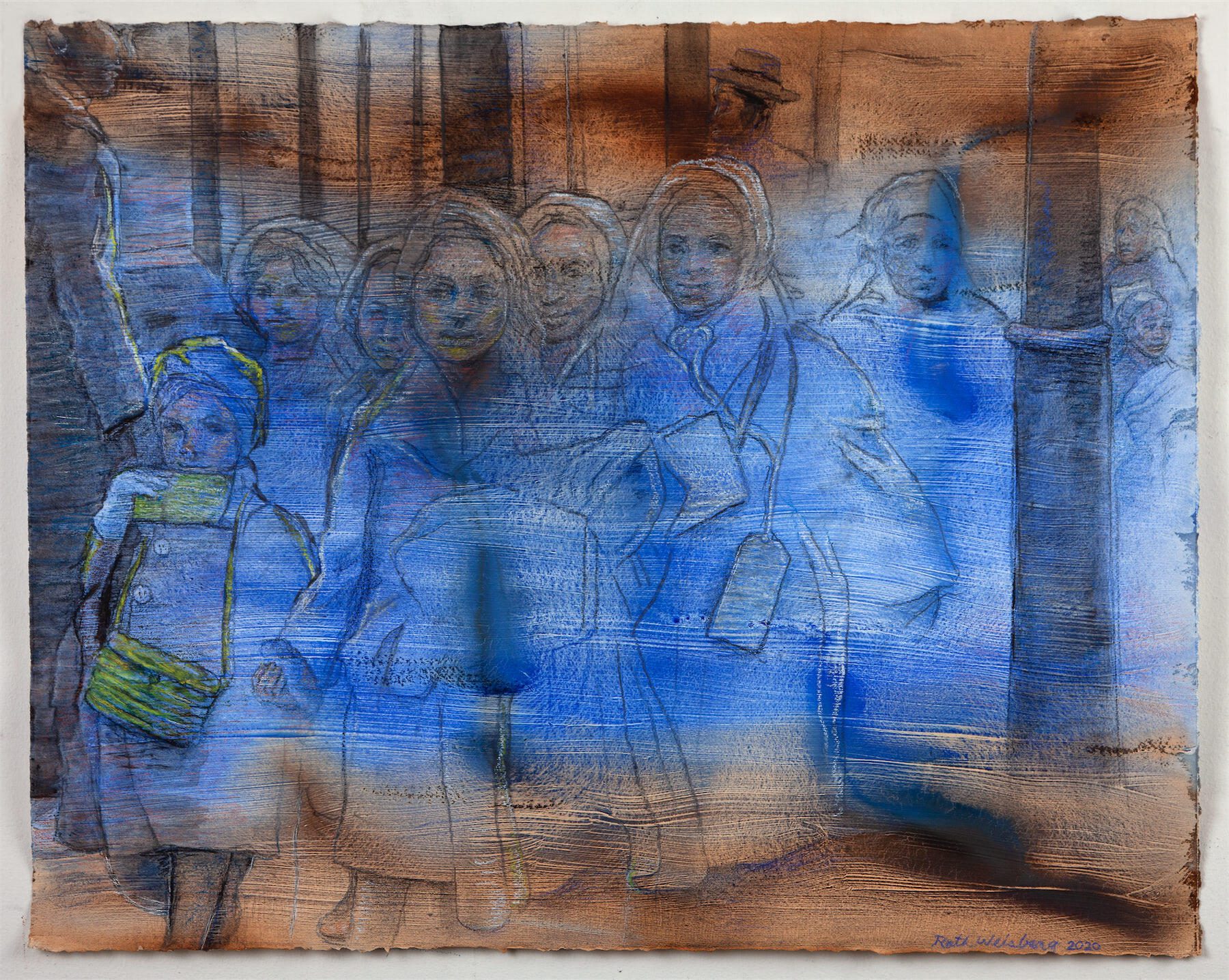Ruth Weisberg: Paving the Way
From art student to dean, Ruth Weisberg has helped clear the path for women artists and educators.
Ruth Weisberg (B. Ed ’64, MA ’65 ) has been a pioneer for women in art and art education at every step of her accomplished career. As a student, professor, and dean. As an organizer, activist, and leader. As a working artist exhibiting at major galleries and museums around the country. And even as a guest at a faculty Christmas party, Weisberg has made space for women in a field once controlled by men.
“I was the first woman over and over and over again,” she says.

“I was the first woman over and over and over again”
Growing up in Chicago, Weisberg and her sister were raised by an architect father and a mother who was “president of everything she was a part of.” Their dad would take them on architectural tours of the city that inspired her sister to study drafting in high school (a first for a girl at their school) and then architecture at the University of Michigan in the mid 1950s. On her sister’s first day, Weisberg says the dean looked out at the class of 100 freshmen and said only 25 would finish the program, adding, “I can guarantee that the two women in the audience will not be among them.” (Her sister would graduate 10th in her class.)
A few years later, Weisberg arrived on campus, ready for adventure. After finishing a “very good and exciting” freshman year, she traveled to Italy for a summer program and ended up staying three years to earn an art degree from the Accademia di Belle Arti di Perugia.
Back in Ann Arbor in the 1960s, she completed a semester to earn her bachelor’s degree at U‑M, where she fondly recalls learning etching and lithography from Emil Weddige. She became close friends with fellow art students Al Loving and Wyn Cortes (who later married) and lived and worked out of a house on Division Street, where a young Iggy Pop and other well-known musicians lived upstairs. Working with Robert Ashley’s experimental performance troupe the ONCE Group, she took part in art performances around town, sometimes building multi-level structures from which members would perform. When experimental painter Robert Rauschenberg came to visit, Weisberg helped with the technical side of his act, which included “wrangling” eight-to-a-dozen tortoises before the famous post-modernist came out on stilts to “kind of dance among the tortoises, moving slowly.”
“It was a wonderful time in Ann Arbor — the pool of experimentation and the avant garde,” she says. “It was really terrific.”
Not everyone was as open-minded. When Weisberg and Cortez applied for the Masters of Fine Arts program, they were met with a familiar rebuttal for the time from the department.

“Professor Larkin told both of us we would never get jobs and we would just get married and have children and that it was a waste of their resources to put us in the MFA program,” Weisberg says.
As consolation, they were admitted as Masters of Art students before Weisberg took another detour, this time to Paris for a year to work at the famous printmaking workshop at the Atelier 17.
“I was going to show them,” she says.
“I was going to show them.”
After graduation, Weisberg taught drawing at Eastern Michigan University in nearby Ypsilanti, Michigan, before heading to Los Angeles in 1969 aftering winning a Ford Foundation grant housed at UCLA. While the all-male faculty there wouldn’t even return her calls — “there was so much sexism at the time. You can’t imagine,” she says — she found an ally in USC art school associate dean Lee Chesney, who invited her to openings, introduced her to people, and eventually hired her.
“There were three women on the USC faculty when I joined; I was the third,” Weisberg says.
“But that was better than nothing. Much better than nothing.”
For perspective, Weisberg says many art schools had no women faculty at the time, since the 1970s marked the very beginning of the first real era of the women’s movement. While she had the support of her peers in pushing back on the established norms of art schools run by white, male faculty, it was a slow climb. Originally hired as a visiting professor, Weisberg became a regular faculty member in 1975 and was soon promoted again when another professor fell ill.
“I went from being kind of nothing to being in charge of the printmaking area of quite a prestigious school, so it was wonderful,” she says.
Although she was finally getting recognized for her talents and hard work professionally, Weisberg still remembers little ways things were different for her from her colleagues. For instance, when the invitation came for the school Christmas party — “not a holiday party,” notes Weisberg, who is Jewish — it welcomed her and her “wife” to attend. When she stopped by the dean’s office to note that she didn’t have a wife but would be happy to bring her husband he said, “of course you’ll come with your husband, but you wouldn’t expect me to use a word like ‘spouse’ would you?”
“I was really in a generation of change,” Weisberg says. “Some of it was very dramatic, some of it fought over, and some of it slid into.”

“I had shown work in exhibitions at the Art Institute of Chicago and the Detroit Institute of Art. I mean, my career was going rather well, but being a woman artist or a woman faculty member, it took some real guts and sticktoitiveness and nerve because, to some people, you’re practically invisible.”
In addition to advancing her own career, Weisberg was actively working to raise the visibility of other women artists in L.A. at this time, as the voices of like minded women artists and educators also started making themselves known around the country. In the mid-’70s, she launched the L.A. chapter of the Women’s Caucus for Art with the help of artist and educator Judith K. Brodsky from Rutgers University. Originating in New York, the non-profit organization was founded a few years earlier and is dedicated to supporting women artists, art historians, arts educators, and museum professionals. She also was one of the first two artists whose work was exhibited at L.A.‘s new Women’s Building, a non-profit arts and education center.
Weisberg eventually became dean of the art school at USC, a position she held for 15 years. Under her leadership, the school took on a more national and international focus, grew significantly in size, and became endowed as the Roski School of Art and Design.
In the early 1990s, she became the first woman artist to lead the College Art Association in its 100 year history as president (two women had held the position before, both art historians). During her time as president, she had the good fortune of running into the U‑M professor who had told her an MFA would be wasted on her 30 years earlier when the two were attending the same conference. (“That really tickled me,” she says.)
Throughout her career as an educator and organizer, Weisberg never stopped working as an artist, including some major exhibits during her deanship. Inspired by the work of the old masters and themes of womanhood, family, and her Jewish heritage, Weisberg’s prints, drawings, paintings, and large-scale installations have appeared in 80 solo exhibits and 200 group shows internationally, including at the Whitney Museum of American Art in New York and the Skirball Museum in L.A., along with many other galleries around the country. Over the summer, U‑M’s Stamps Gallery hosted a small retrospective of her work. Weisberg has stayed connected to Ann Arbor over the years through family and collectors who still live in the area, and the show featured some prime examples of her earlier work.

Looking back on her career and the impact she was able to have as a woman artist and educator, Weisberg gives a lot of credit to being at the right place at the right time.
“I was the first woman to do various things, or to receive various things, because that’s the generation I’m in,” she says. “I’m of an age and a generation that, if it was going to happen, we were going to be the first. There were wonderful women to look up to as artists, but sometimes they were mocked or not taken as seriously as they should have been or had to wait longer for recognition.”
For all those she’s proven wrong along the way, Weisberg says her journey has also been full of its own rewards.
“The path that I had to veer onto turned out to be terrific,” she says.
Story by Eric Gallipo.